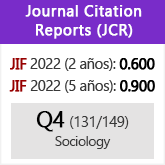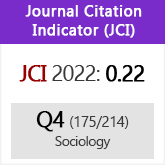La conceptualización de redes como ensamblajes. Estudio de un caso práctico en el sector cerámico español
DOI:
https://doi.org/10.3989/ris.2009.06.29Palabras clave:
Ensamblaje, Innovación, Redes SocialesResumen
El concepto de redes sociales es muy influyente en la explicación de la interacción social en las organizaciones. Muchas de las características sociológicas de las organizaciones se explican también por las redes sociales, pero el concepto tiene limitaciones importantes. Algunas teorías de las redes están hechas de fragmentos de otras teorías, otras se basan en modelos que son esencialistas o reduccionistas. Otro problema es que las redes pueden describir las relaciones de los objetos, pero no los explican. En este artículo se describe el concepto de conjunto para resolver estos problemas. El concepto de “ensamblaje” ofrece una clara, aunque compleja, estructura para mostrar las dinámicas de las relaciones de los distintos elementos en las organizaciones. Basándose en ejemplos recientes en el área de la innovación y en el análisis de un caso práctico en el sector cerámico español, este artículo ilustra cómo el conceptualizar las relaciones entre diferentes redes en términos de su “ensamblaje” permite un marco teórico más robusto para la investigación de redes.
Descargas
Citas
Ahuja, G. 2000. “Collaboration networks, structural holes and innovation: A longitudinal study.” Administrative Science Quarterly 45 (3): 425–455. doi:10.2307/2667105
Allent, T. J. 1977. Managing the Flow of Technology. Cambridge: MIT Press.
Archer. M. 1995. Realistic Social Theory: The Morphogenetic Approach. Cambridge: Cambridge University Press. doi:10.1017/CBO9780511557675
Bhaskar, R. 1997. “On the Ontological Status of Ideas.” Journal for the Theory of Social Behaviour 27 (2/3): 139-147
Borgatii, S.P. and P.B. Foster. 2003. “The network paradigm in organizational research: A review and typology.” Journal of Management 29 (6): 991-1013
Brass, D.J., J. Galaskiewicz, H.R. Greve and W. Tsai. 2004. “Taking stock of networks and organizations: A multilevel perspective.” Academy of Management Journal 47 (6): 795-817 doi:10.2307/20159624
Burkhardt, M.E. and Brass, D.J. 1990. “Changing patterns or patterns of change.” Administrative Science Quarterly 35 (1): 104-127 doi:10.2307/2393552
Burt, R.S. 1992. Structural Holes: The Social Structure of Competition. Cambridge: Harvard University Press.
Burt, R.S. 2004. “Structural holes and good ideas.” American Journal of Sociology 110 (2): 349-399 doi:10.1086/421787
Callon, M. 1992. “The dynamics of techno-economic networks” Pp. 77–102 en R. Coombs, P. Saviotti, V. Walsh, (coord.) Technological change and company strategies. London: Harcout Brace Jovanovich.
Callon, M. 1998. The Laws of the Markets. Oxford: Blackwell.
Callon, M. 2005. “Why Virtualism paves the way to Political Impotence.” Economic Sociology: European Electronic Newsletter 6/2 (February): 3–20
Castell, M. 1996. The Network Society, The Information Age. Oxford: Blackwell.
Collier, S. and ONG. A. 2005. “Global Assemblages, Anthropological Problems”. Pp. 3-21. In A. Ong and S. Collier (ed.). Global Assemblages: Technology, Politics and Ethics as Anthropological Problems, London: Blackwell.
Cooke, P. and Wills, D. 1999. “Small Firms, Social Capital and the Enhancement of Business Performance through Innovation Programmes.” Small Business Economics 13: 219-234. doi:10.1023/A:1008178808631
Cowan, R. and Jornard, N. (2004), “Network Structure and the Diffusion of Knowledge.” Journal of Economic Dynamics and Control 28 (8): 1557-1575 doi:10.1016/j.jedc.2003.04.002
Debresson, C. and Amesse. F. 1991. “Networks of Innovators.” Research Policy 20 (5): 363-379 doi:10.1016/0048-7333(91)90063-V
Delanda, M. 2006a. A New Philosophy of Society: Assemblage Theory and Social Complexity. London: Continuum.
Delanda, M. 2006b. “Deleuzian Social Ontology and Assemblage Theory”. Pp. 250-267 M. Fuglsang and B.M. Sorensen (ed.) Deleuze and the Social Edinburgh: Edinburgh University Press.
Delanda, M. 2010. Deleuze: History and Science. New York: Atropos.
Deleuze, G. and Guattari, F. 1988. A Thousand Plateaus. London: Athlone Press.
Deleuze, G. and Parnet, C. 1987. Dialogues. London: Athlone Press.
Emirbayer, M. and Goodwin, J. 1994. “Network Analysis, Culture and the Problem of Agency.” American Journal of Sociology 99 (6): 1411-1454 doi:10.1086/230450
Freeman, C. 1991. “Networks of innovators: A synthesis of research issues.” Research Policy, 20 (5): 499–514. doi:10.1016/0048-7333(91)90072-X
Giddens, A. 1986. The Constitution of Society: Outline of the Theory of Structuration. Berkley: University of California Press.
Gould, R. 1991. “Multiple Networks and Mobilization in the Paris Commune 1871.” American Sociological Review 56 (6): 716-729 doi:10.2307/2096251
Granovetter, M. 1973. “The Strength of Weak Ties.” The American Journal of Sociology 78 (6): 1360-1380. doi:10.1086/225469
Granovetter, M. 1983. “The Strength of Weak Ties: A Network Theory Revisited.” Sociological Theory 1 (1): 201-233 doi:10.2307/202051
Haypes, P. 2008. Assemblages - Rethinking Networks of Innovation within the Ceramics Sector, First International Sociological Association Forum. Barcelona: September 5-8.
Hervas, J.L. and Dalmau, J.I. 2005. “How to Measure IC in Clusters: Empirical evidence.” Journal of Intellectual Capital 7 (3): 354-80
Kilduff, M., Tsai, W. and Hanke, R. 2006. “A paradigm too far? A dynamic stability reconsideration of the network research program.” Academy of Management Journal 31 (4): 1031-1048.
Latour, B. 2005. Reassembling the Social. Oxford: Oxford University Press.
Lewrick, M.R. Raeside, R. and Peisl, T. 2007. “The Innovator’s Network.” Journal of Technology Management and Innovation 2 (3): 12-24
Lundvall, B. 1992. National Systems of Innovation: Towards a Theory of Innovation and Interactive Learning. London: Pinter.
Marcus, G.E. and Saka, E. 2006. “Problematizing Global Knowledge – Assemblage.” Theory Culture and Society 23 (2-3): 101-106 doi:10.1177/0263276406062573
Arsden, P.V. 1990. “Network Data and Measurement.” Annual Review of Sociology 16: 435-463 doi:10.1146/annurev.so.16.080190.002251
Meyer-Stamer, J. Maggi, C. and Siebel, S. 2001. “Improving Upon Nature: Creating Competitive Advantage in Ceramic Tile Clusters in Italy, Spain and Brazil”, INEF Report 54
Molina, F.X. 2005. “The Territorial Agglomerations of Firms: A Social Capital Perspective from the Spanish Tile Industry.” Growth and Change 35 (1): 74-99 doi:10.1111/j.1468-2257.2005.00267.x
Molina, F.X., Martinez, M.T., Ares, M.A. and Hoffman V.E. 2008. La Estructura y Naturaleza del Capital Social en las Aglomeraciones Territoriales de Empresas. Bilbao: Fundación BBVA.
Moreno, A. 2006. “Ceramic Tiles: Above and Beyond Traditional Applications.” Cerámica y Vidrio 45 (2): 59-64.
Nelson, R. and Winter, S. 1977. “In Search of a Useful Theory of Innovation.” Research Policy 6 (1): 36-76. doi:10.1016/0048-7333(77)90029-4
Obstfeld, D. 2005. “Social Networks, the Tertius Lungens Orientation, and Involvement in Innovation.” Administrative Science Quarterly 50 (1): 100-130
Owen-Smith, J. and Powell, W.W. 2004. “Knowledge networks as channels and conduits.” Organization Science 15 (1): 5-21 doi:10.1287/orsc.1030.0054
Padgett, J.F. and C.K. Ansell. 1993. “Robust Action and the Rise of the Medici, 1400-1434.” American Journal of Sociology 98 (6): 1259-1319 doi:10.1086/230190
Parkhe, A., Wasserman, S. and Ralston, D. 2006. “New frontiers in network theory development.” Academy of Management Review 31 (3): 560–568
Powell, W.W., K. Koput and L. Smith-Doerr. 1996. “Interorganizational Collaboration and the Locus of Innovation.” Administrative Science Quarterly 41 (1): 116-145 doi:10.2307/2393988
Russo, M. 1985. “Technical Change and the Industrial District: the role of Interfirm Relations in the Growth and Transformation of Ceramic Tile Production in Italy.” Research Policy 14 (6): 329-343 doi:10.1016/0048-7333(85)90003-4
Salancik, G.R. 1995. “WANTED: A good network theory of organization.” Administrative Science Quarterly, 40 (2): 345– 349 doi:10.2307/2393642
Sassen, S. 2006. Territory, Authority, Rights: From Medieval to Global Assemblages. Princeton and Oxford: Princeton University Press.
Sorenson, O. 2003. “Social Networks and Industrial Geography.” Journal of Evolutionary Economics 13 (5): 513-527 doi:10.1007/s00191-003-0165-9
Tracey, P. and G.L. Clark. 2003. “Alliances, Networks and Competitive Strategy: Rethinking Clusters and Innovation.” Growth and Change, 34 (1): 1-16 doi:10.1111/1468-2257.00196
Wasserman, S. and K. Faust. 1994. Social Network Analysis: Methods and Applications. Cambridge: Cambridge University Press.
Wellman, B. and S.D. Berkowitz. 1997. Social Structures: A Network Approach. Greenwich: JAI Press.
White, H.C. 1995. “Social networks can resolve actor paradoxes in economics and in psychology.” Social Structures 151: 58–74.
Yu, G., J. Gao, J.C. Hummelen, F. Wudl and A.J. Heeger. 1995. “Polymer Photovoltaic Cells: Enhanced Efficiencies via a Network of Internal Donor-Acceptor Heterojunctions.” Science 270: 1789–1791. doi:10.1126/science.270.5243.1789
Descargas
Publicado
Cómo citar
Número
Sección
Licencia
Derechos de autor 2011 Consejo Superior de Investigaciones Científicas (CSIC)

Esta obra está bajo una licencia internacional Creative Commons Atribución 4.0.
© CSIC. Los originales publicados en las ediciones impresa y electrónica de esta Revista son propiedad del Consejo Superior de Investigaciones Científicas, siendo necesario citar la procedencia en cualquier reproducción parcial o total.Salvo indicación contraria, todos los contenidos de la edición electrónica se distribuyen bajo una licencia de uso y distribución “Creative Commons Reconocimiento 4.0 Internacional ” (CC BY 4.0). Puede consultar desde aquí la versión informativa y el texto legal de la licencia. Esta circunstancia ha de hacerse constar expresamente de esta forma cuando sea necesario.
No se autoriza el depósito en repositorios, páginas web personales o similares de cualquier otra versión distinta a la publicada por el editor.

















